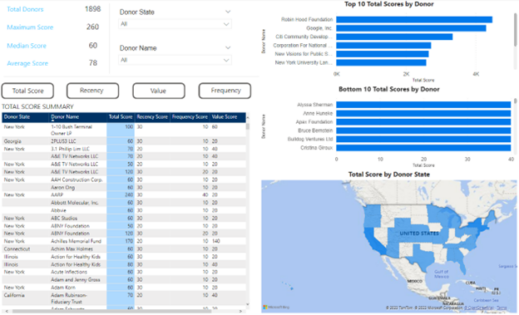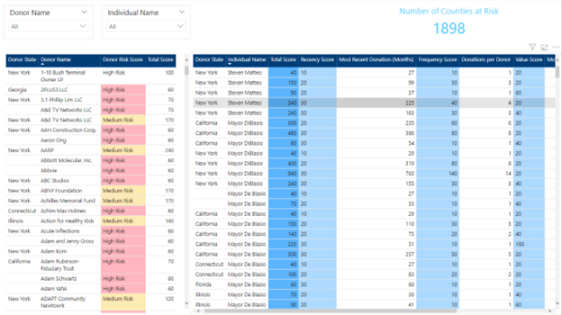The RSM DDS Data Analytics team recently created Power BI reports that tracks Member Scoring Analytics for Not-For-Profit (NFP) organizations. These reports were explicitly developed to determine engagement and participation scores for the charitable, education, association, and foundation sectors within the NFP industry. Continue reading below to see the features of these reports and how the resulting insights can benefit your NFP clients!
NFP Analytics Trends
Many common trends are occurring throughout the Not-For-Profit industry, which provides new analytics opportunities for the organizations involved. However, there are also challenges and limitations that many organizations encounter when considering and implementing these new analytics capabilities. This section provides additional information and opportunities regarding Engagement and Member Tracking, Advanced Analytics, and some examples of organizational limitations that NFPs may face.
Engagement and Member Tracking
Digital Marketing Strategy
Not-for-Profits are looking for ways to utilize data on their members to track engagement and demographics across their organization. In addition, as Not-for-Profits are using more social media, they’re looking for ways to leverage that data for targeted marketing and communication.
Virtual Events
Due to COVID-19, Not-for-Profits hosting virtual events have access to wider audiences and need more robust fundraising and programming systems.
Advanced Analytics
Machine Learning
Organizational data is beginning to be used for targeted marketing initiatives and analyzing comment sentiment on engagement.
Predictive Analytics
Donors and donations data can be utilized to predict when a donor will cease giving money to an organization and identify the characteristics of a likely donor. Predicative analytics can help organizations be aware of when specific changes may occur.
Organizational Limitations
Funds and Expertise
The desire for improved analytics and data strategy practices can be complicated by potentially limited funds and a lack of IT staff.
Misconceptions about Feasibility
Many Not-For-Profits view advanced analytics and data strategy as only available for large organizations, whereas many widely used technology is affordable and open source. This allows for additional capabilities to be accessible to most organizations.
Member Scoring – Overview
Association Member Scoring
Member Scoring is the process of numerically evaluating the engagement of the organization and its individual members. This process involves calculating a weighted score based on engagement and participation. Implementing and leveraging a centralized data warehouse allows for flexible and easily maintained calculations and scoring, which is necessary to support this process. Member scoring also enables NFP organizations to take advantage of current analytics trends, such as tracking engagement and member participation, and utilize machine learning and predictive analytics to target potential individuals for marketing purposes.
Actionable Insights
The following are examples of questions NFP organizations commonly ask regarding engagement to determine whether they are meeting specific goals; these insights allow organizations to respond and take necessary actions.
- Do we target specific members and/or chapters with low engagement?
- Are there individuals we can target to lead initiatives or sit on boards and committees?
- Are there patterns or commonalities in low engagement groups (location, age, etc.)?
Answering these questions determines whether the organization and its members are meeting goals regarding engagement and participation. In addition, the insights gained from member scoring allow organizations to respond and take necessary actions to improve performance in these areas.
Member Scoring – Data Warehouse
Engagement Scoring
Engagement scoring allows an organization to use its data to evaluate member interaction with programs, events, leadership opportunities, and other programming hosted by the organization. An engagement score is the weighted aggregation of a member’s participation and engagement with an NFP’s efforts. These scores can be assigned at the organization and individual member levels of detail. This can be done to focus on performance, regarding engagement, for both individuals and the entire organization. This blog will explore a member scoring implementation example and potential use cases for leveraging this solution in a charitable organization.
Engagement Scoring: Parameters and Logic
The total engagement score equals the weighted average of the individual scores. The business decides weights and points and the importance of organizational engagement. The following visual shows an example of how an organization could prioritize activities to derive a score.



In this example, the Maximum Points from Programs, Events, and Committee Involvement would be added to equal a final engagement score of 85.
Data Movement
In coordination with the RSM Dynamics CE team, the implemented processes ensured integrity throughout data movement.

First, the scores are assigned in Dynamics CE, which triggers rules that give points to the member organization. Next, Azure Data Factory runs on a scheduled refresh to bring changes and additions into the data warehouse. This is where the raw data is transformed into a modeled format usable in Power BI. Lastly, Power BI connects directly to the data warehouse to visualize the scoring.
Engagement Scoring Matrix
Members Engagement Matrix
When evaluating engagement at the member level of detail, a matrix visual displays data by individual person and year. The information used in these visuals is based on transactional member data. The below table shows an example of how these visuals are presented.

Aggregate Organization Engagement Matrix
Determining engagement at the organization level of detail involves an aggregation of the participation of all individuals, which is based on the Members Engagement Matrix. The total risk level can be derived through logic that includes member count, length of membership, and other necessary metrics. The full engagement score is the weighted average calculation discussed in the previous Engagement Scoring sections.

Member Scoring – Power BI Reports
The engagement and participation data is modeled, transformed, and visualized in a Power BI report that captures additional insights for more informed decision-making and analysis. Four Power BI reports correspond to each NFP sector: charitable, education, association, and foundation. The following image shows visuals from the charitable sector Power BI report.

Each of the four sectors will define individual scores that are added together to calculate the final engagement score. For example, the charitable sector report details information focused on donors and assigns three separate scores for recency, frequency, and value. The recency score determines when the last donation was provided by a donor based on months. The frequency score is derived from the number of donations per individual donor. Finally, the value score translates the monetary amount of the donations based on a range of values. The sum of the recency, frequency, and value scores will equal the final engagement score for an NFP organization in the charitable sector. The following image displays the scoring report page from the charitable sector Power BI report.

That concludes this blog post regarding member scoring analytics for NFP organizations. Thank you for reading this blog post, and feel free to contact our professionals here for any additional questions or information!

 RSMUS.com
RSMUS.com


